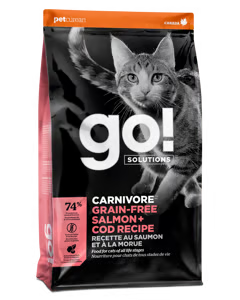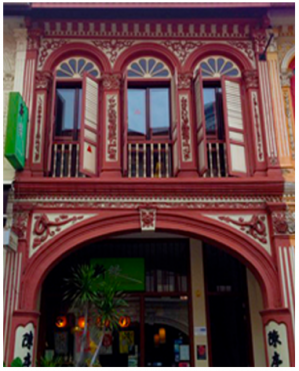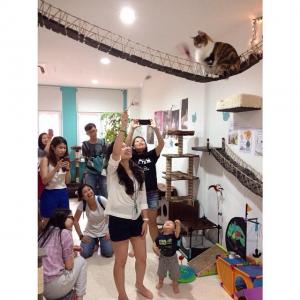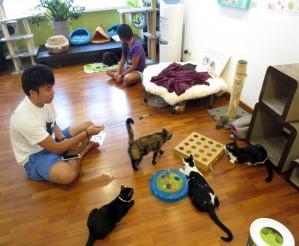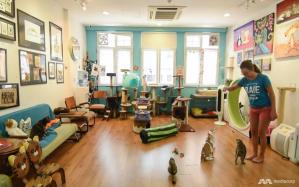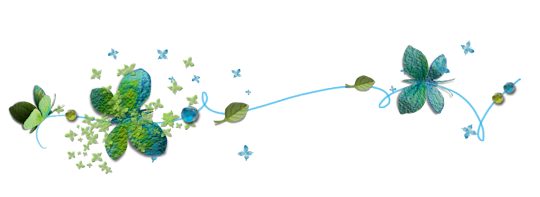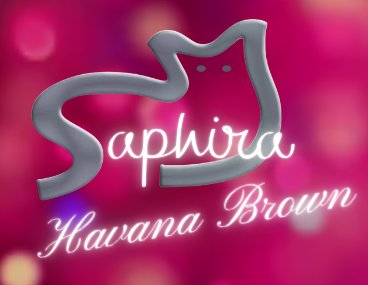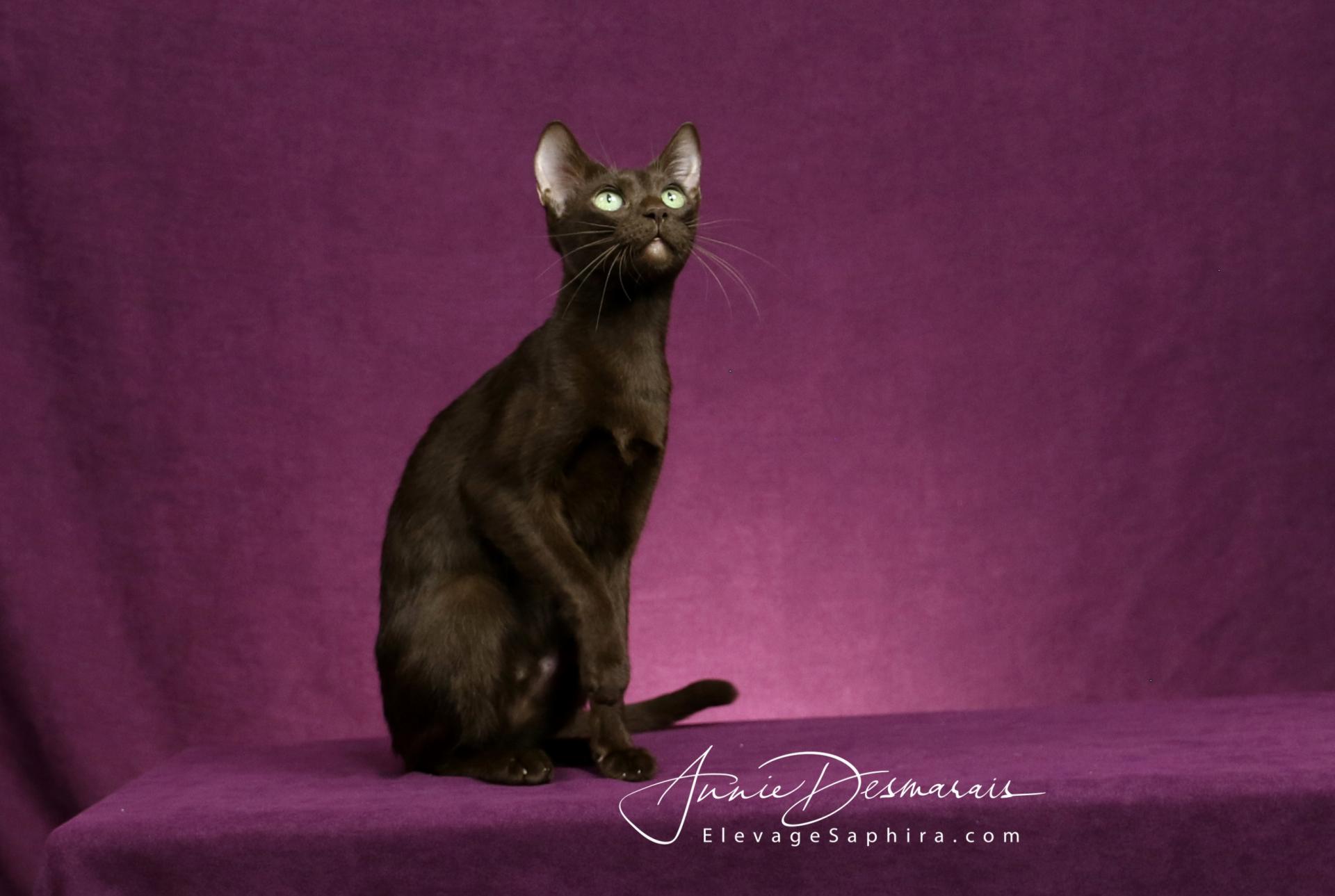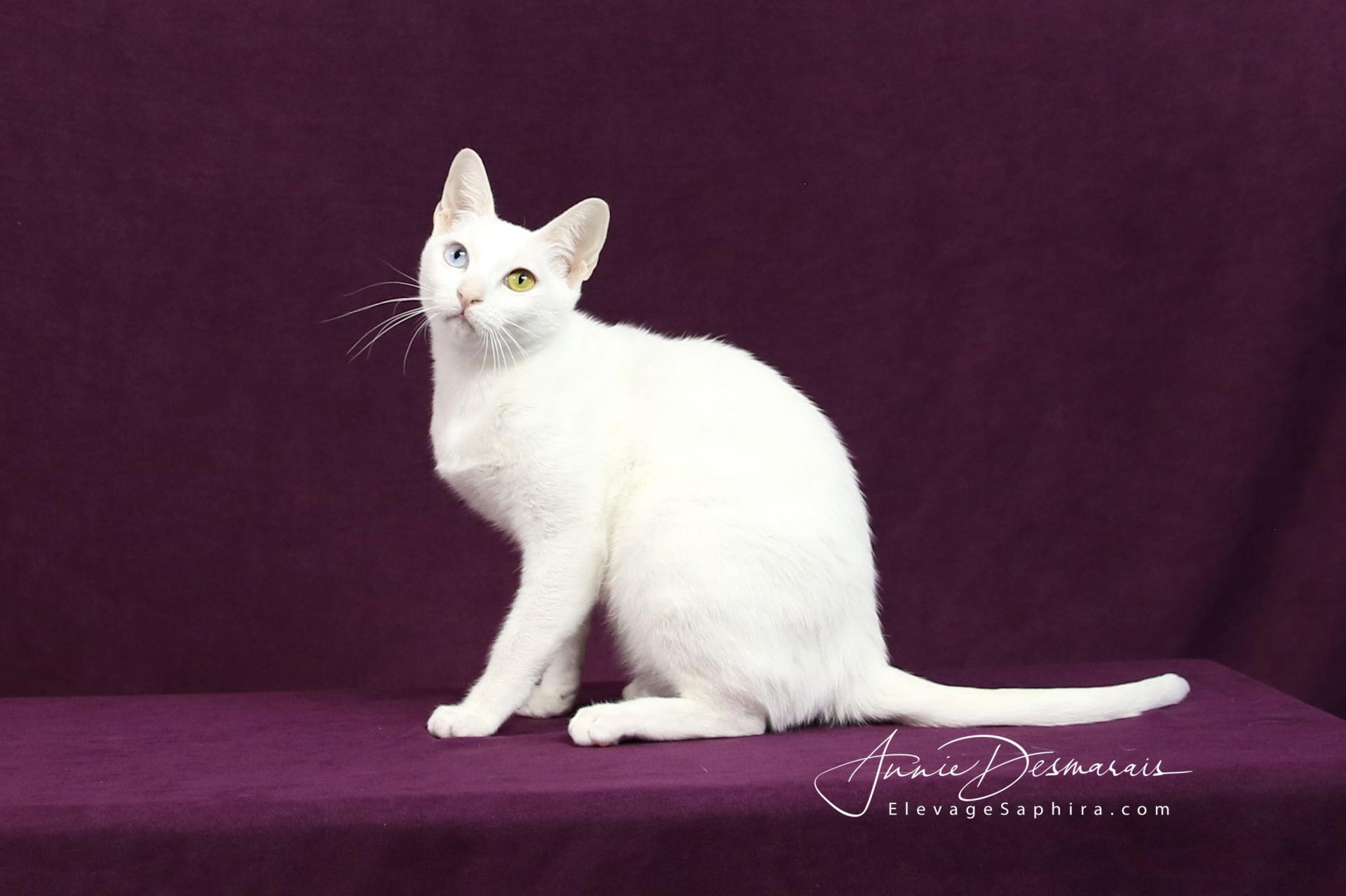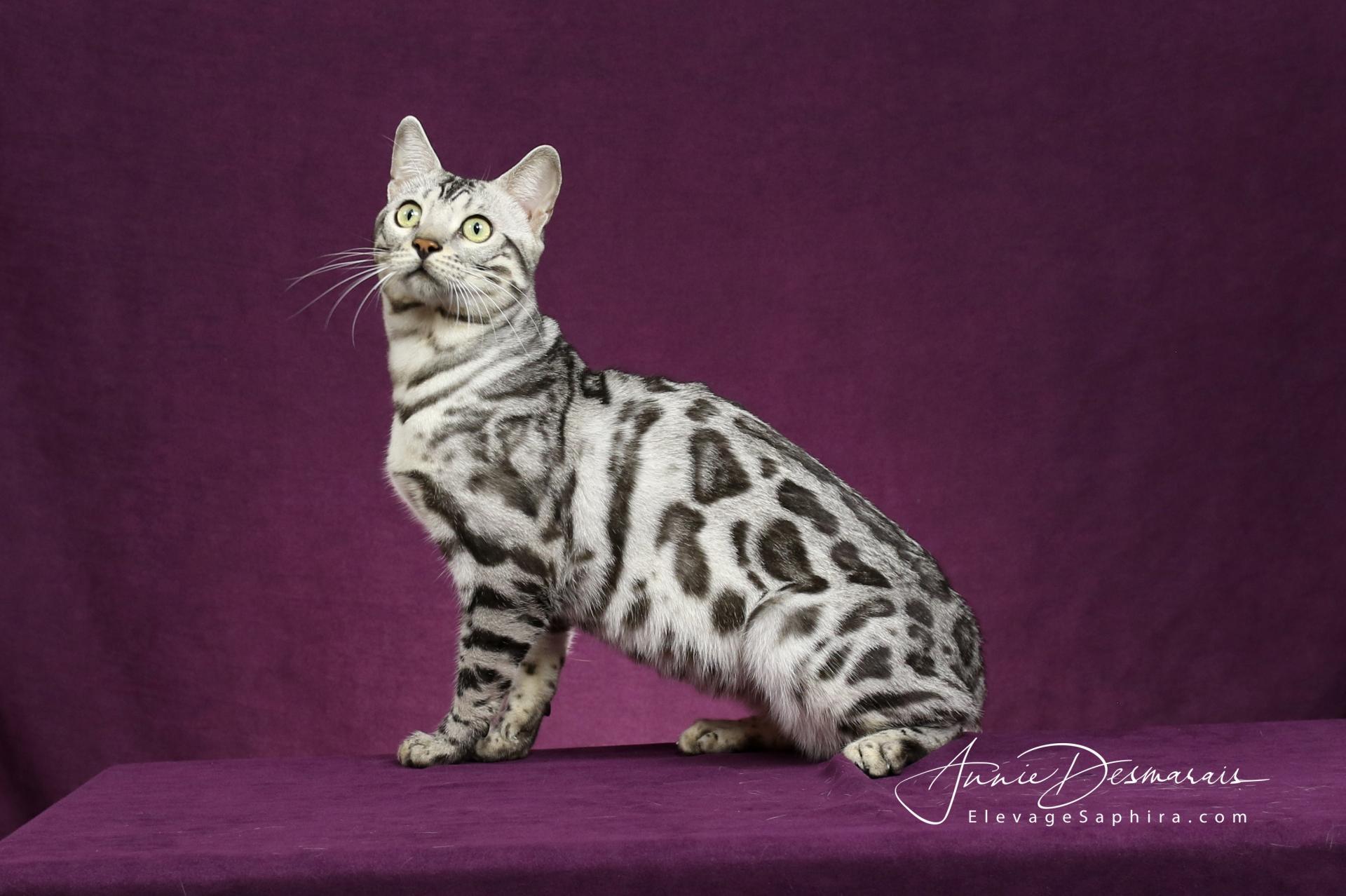Khao Manee - The Breed
Origin
The Khao Manee is a cat originally from Siam, now Thailand. The pronunciation is ''Kow Mani''.
It is a very old natural breed (they developed without the intervention of humans). According to several accounts, some dating back to the 14th century, the Khao Manee is considered by the Thais as a lucky cat. Indeed, the Tamra Maew, the classic Thai book of cat poetry dating from 1350 to 1767, refers to the Khao Manee as Khaao Plort, which means "all white".
Its current name refers rather to its dazzling eyes, since the translation of Khao Manee from Thai to english means "diamond eyes".
A Royal Cat !
A legend about the Khao Manee is very interesting! In addition to being considered in Thailand as a lucky cat, the Khao Manee was also the favorite cat of the King of Siam, Rama V, who reigned from 1868 to 1910. It is said that King Rama V had all Khao Manee cats in the palace hidden when the English and the French arrived. Cats of this breed were kept away by members of the royal family. As for the King, he would have presented the Siamese to the English and the French (today this breed is called Thai, since it refers to the old Siamese (or Traditional Siamese) with the "Apple Head" type head) as being the royal breed, in order to preserve the true royal breed, the Khao Manee!
It is even said that during the reign of King Rama V, the death penalty was inflicted on anyone who dared to steal a Khao Manee! This demonstrates once again the royal and special status of this breed!
Later, King Rama V would have donated his 9 Khao Manee cats to his son, Prince Chumphon Khet Udomsak, so that he could breed Khao Manee. Then, it was the turn of his daughter to take over, Princess Ruang Jit Jarang Apakorn. She increased the herd from 18 cats to 40. In 1957, the princess entrusted the cats of the royal breeding to another member of the family, Colonel Haw Pionudhad. The latter also increased the stock but in a more considerable way, that is to say to 300 subjects, but this number knew a decline thereafter.
,
Currently, the royal breeding is in the care of the grandson of Colonel Haw Pionudhad, Namdee Witta. Until 2011, the royal cattery, which consists of about 50 Khao Manee, was open to the public, but has not been open to the public since then. Namdee Witta takes care of the cats and always breeds them according to the rules that had been decreed by King Rama V, that is to say the prohibition to cross Khao Manee with other breeds and to sell them to anyone. Namdee Witta affirmed in an interview published in a Thai magazine, that he would have even refused an astronomical sum from a sheikh of Saudi Arabia, who insisted to have one of the cats in his care.
For many years, the Khao Manee remained only in Thailand since the country prohibited its export. Over time, the Khao Manee had become an endangered breed. However, in 1999, Mrs Colleen Freymuth, an American breeder located in Phoenix, Arizona and a specialist in endangered species, managed to obtain the authorization to export some of them in order to set up the very first breeding program, and thus try to ensure the perenniality of the breed.
She first imported a female that she named Sripia and which was shipped to the USA with her 4 kittens. She also imported a male, and Mrs. Freymuth was the one who produced the very first litter on Western soil. She imported a total of 12 cats from Thailand to the United States for breeding purposes.
Later, Frédéric Goedert, a French poet and breeder of Korat cats, became interested in the Khao Manee, which he did not yet know existed. In 2004, Mr. Goedert went to Thailand to bring back a first Khao Manee, a female named Paï Lin, which means ''Blue Sapphire''.
Afterwards, Colleen Freymuth sent him 6 other cats in order to allow him to start his breeding program of Khao Manee. In 2005, Colleen Freymuth had to abandon her Khao Manee breeding program for health reasons. She sent her cats to Frédéric Goedert in France so that he could take over and continue the work she had started.
And it is in 2005 that the first litter of Khao Manee was born in France. Frédéric Goedert was for a long time the only breeder of Khao Manee in the West.
The Khao Manee is a "new" breed in North America and the United Kingdom, but is not new in Thailand, its country of origin.
The Khao Manee is one of the rarest breeds in the world, and is threatened with extinction, just like the Havana Brown. In addition, a program involving several breeders in different countries is currently in place. This program aims to select the best subjects in Thailand and to breed them, in order to make this magnificent natural breed accessible all over the world.
Temperament
The Khao Manee is a very intelligent cat, extroverted, active and mischievous, dynamic, curious, agile, sociable, gentle, sensitive and very attached / loyal to its owners. In addition, it is an affectionate cat who loves to snuggle up to his master. Even if he appreciates the company of his feline and canine companions in the household, he generally prefers the company of his humans. This breed adapts very well to life in an apartment.
Very sociable by nature, they will easily meet your visitors.
The Khao Manee is very talkative, and its characteristic meowing will make many smile... But it could nevertheless become annoying for some people, don't forget that it is a distant cousin of the Siamese! ;-) So get ready to have great conversations with your feline companion!
Morphology
The main characteristic of the Khao Manee of other breeds of cats is its silky, fine, short ermine white coat, bringing out its sparkling, bewitching and diamond shining eyes. In short, the Khao Manee will hypnotize you from the first glance!
The color of their eyes, contrasting with the whiteness of their coat, is what distinguishes them the most, like 2 jewels set in marble. Their color can vary from mercury blue (blue gray very light), through sapphire blue, emerald green, peridot green, or sapphire yellow and amber. The most popular eye color is definitely minnow eyes (i.e. the eye color is mismatched), since these cats are supposed to bring good luck and good fortune. And let's face it, it's absolutely beautiful!
Note that Khao Manee kittens are born completely pink, and take on their ermine white color only later on.
Her paw pads and nose are pink, slightly reddish.
Considered as a small to medium size breed, one can nevertheless observe a flagrant sexual dimorphism between males and females of this breed. Indeed, the females are finer and the males are more massive. The weight of an adult Khao Manee can vary from 3 to 7Kg approximately, more specifically from :
- 2.5Kg (5.5lb) to 3.5Kg (8.0lb) for females
- 3.5Kg (8.0lb) to 4.5Kg (10.0lb) for Males
The Khao Manee is endowed with a supple, muscular and harmonious body, while remaining a slender, graceful and elegant cat, reminiscent of royalty's standards.
His bones are quite fine. His hind legs are slightly longer than his front legs. He has a slightly broken profile.
Khao Manee's head is triangular in shape with rounded contours, and his ears are medium sized, rounded and straight. It also has characteristic prominent cheekbones.
Its life expectancy is about 14 years.
Grooming
The Khao Manee has a short dress, and requires little maintenance. A simple weekly brushing will be more than enough to keep the full splendor of its coat.
Since it has no undercoat, it loses less hair compared to the domestic cat.
Khao Manee's light-colored eyes may require a light cleaning on a regular basis.
Do not forget the claws trimming which should be done approximately every 16-18 days, if not needed.
Food
The Khao Manee does not have any food specificity like some breeds, but it is still necessary to make sure to offer him croquettes of superior quality.
At Saphira Cattery, all our kittens and adult cats are fed with GO! – Salmon & Cod recipe (Grain free and Corn free).
See photo of the bag on the side.
Genetic diseases
Just like other white cats with blue eyes, the Khao Manee is prone to deafness problems. However, this problem is less frequent in this breed, which may indicate a certain rigor in the breeders' selection work.
In general, it happens that blue-eyed white cats are affected by deafness, but this genetic defect is much rarer in the Khao Manee than in other blue-eyed white cats such as the Foreign White.
In fact, of all cat breeds (domestic cats, Persians, Maine Coon, etc...), 72% of blue-eyed white kittens are likely to be born deaf.
This congenital handicap is due to the mutation of a gene affecting the melanocytes, i.e. the cells responsible for hair pigmentation. These same cells (melanocytes) also influence the development of the inner ear. Therefore, when the melanocytes do not develop normally, communication between the ear and the brain is affected, causing deafness in cats.
The correlation with blue eyes stems from the fact that this color is due to a lack of pigmentation in the iris, caused by the same genetic mutation. This correlation is so strong that cats with minnow eyes may be deaf in one ear, the ear on the same side as the blue eye.
Otherwise, Khao Manee is not subject to other genetic diseases. It is a robust breed, like the vast majority of natural breeds, and is resistant to common diseases and parasites. This allows us to believe that there has been a long selection process that was done in its country of origin, which makes this resistant and healthy breed even more attractive! However, special attention must be paid to its eyes, which are a little more fragile.
Are all Khao Manee born white?
No indeed, some Khao Manee can be born of another color, even all black, but this is not what is ''standard'' in the breed. Some breeders will still keep these kittens for their breeding program while others will only breed white cats with other white cats.
In fact, true white Khao Manee are either homozygous for the W gene (so W/W) or heterozygous (W/w). The W gene is the "dominant white" gene, and the role of this gene is to mask the true color of the cat. It is thus necessary to understand that in feline genetics, white is not a color, but rather an absence of color.
Also, if we breed together 2 non-dominant white cats (so 2 heterozygous cats), we should obtain a small percentage of kittens that have not inherited the W gene (dominant white). And if we take this same cat of color, non-dominant white, and breed it with a dominant white cat, the kittens from this marriage will find the "color" of the breed.
In addition, some subjects may be born with a small black or gray spot on the head, a sign that they are non-dominant white (W/w), which should fade during the first year.
Is my cat a Khao Manee?
It is important to keep in mind that just because a cat is white, it doesn't mean that it is a Khao Manee... It can be a cat from another breed, or a simple white domestic cat.
Only the registration papers and/or pedigree from a recognized cat association can be considered as proof that it is a true purebred Khao Manee!
At Saphira Cattery, all our kittens leave with their official registration document issued by Chats Canada Cats.
As for our adults, they all have an official pedigree, and they are registered with one or more of these following cat associations: CFA (Cat Fanciers Association), TICA (The International Cat Association), and TIMBA (The International Maeow Broan Association).
It is wrong to claim that any white cat with minnow eyes found in a country outside of Thailand is a Khao Manee. A good breeder of purebred Khao Manee will be able to demonstrate and make the link that the kitten's ancestors truly come from Thailand.
There is a genetic test called Cat Ancestry, which is available at UC Davis (California). However, this test will only tell you approximately what part of the world the cat comes from (origin). It is not a test that will confirm the breed. In addition, there is currently no genetic test available that is capable of revealing a cat's breed.
So without a pedigree or official registration documents, we can't say that the cat is of the Khao Manee breed.
The Khao Manee, a lucky cat...
In Thailand, the Khao Manee is considered to be a lucky cat. This popular belief dates back to Tamra Maew, the book of feline poems of the 14th century, in which we can find a poem about a white cat, which was attributed the ability to bring good luck in the homes that welcomed him:
''Eyes like diamonds,
Business is successful and brings prosperity,
Like a priceless jewel,
The one called Sri Parori, white fur,
And a cat with crystal clear eyes,
White whiskers as if applied,
Luck is not long in coming home.''
And here's another poem that can be found in Tamra Maew:
The sixth feline,
entirely white and with clear mercury eyes,
will bring in a longevity home,
recognition and material wealth.
This will not be without also arousing happiness''.
A postage stamp with the effigy of Khao Manee
Thailand issued in 1995, a postage stamp worth 3 bahts with the effigy of Khao Manee. This shows us once again how emblematic this cat breed is for Thailand!
A museum on cats...
There is a museum in Singapore entirely dedicated to domestic cats, the Cat Museum. Visitors will find a wealth of information about cats, but will also be able to interact with some of the feline residents who are on site, and even adopt some of them. In 2016, one could meet a female named Diamond, as well as a male named Papa.
Visit the Museum's website to learn more: https://www.thecatmuseum.com.sg/
Do you know the Khao Manee?
(The video is only available in French but we publish it on this page anyway because some of you understand French. You can also enable automatic subtitles in the language of your choice, available in YouTube settings.)
Connaissez-vous les Khao Manee? ???
Last edited: Sunday, 17 august 2025
